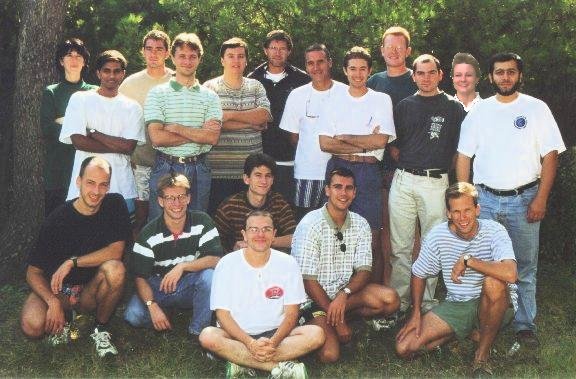The Rodeo Group

This page is out of date, the Rodeo group is now called the Plančte
group.
Rodeo is a contrived acronym that stands for ``High speed networks,
open networks''.
The main objective of the project is to design, implement, and
evaluate mechanisms for the efficient and flexible use of
network resources.
To achieve the above objective, we focus our activities in three main
areas, namely:
This work is performed in relation with academic, research,
and industrial partners.
You will also find in this page a list of project members
and some additional information.
We also have a page in french.
We are designing resource allocation mechanisms for both stateless
networks (such as the current Internet) and integrated/differentiated
services networks.
With stateless networks, resource allocation is done using
edge (i.e. end-to-end) mechanisms. Our emphasis these past
few years have been on mechanisms that
integrate multicast delivery, flexible flow and error
control, etc. These mechanisms are used in
particular in the FreePhone
Internet telephony tool, in the
Rendez-Vous videoconferencing tool (successor
of IVS, one of the first s/w videoconferencing
tool for the Internet) ,
and in the MiMaze distributed
game.
Previous research in the group led to the development of the
MAVROS compiler, and of fast algorithms for the management of data
transparency in heterogeneous systems. We are extending this work so
as to allow the compiler to handle detailed specifications of the
applications. This will lead to further optimizations.
We expect the two research areas described above to eventually
merge within the framework of the Application Layer
Framing (ALF) architecture. It will then be possible to take into
account specifications of an application, of the network ressources
required by the application, and to automatically generate tailored
communication modules that handle both data transparency,
synchronization, and transmission control for this application.
Our work is carried out over IP networks using a variety of underlying
technologies. Recently, we have carried out specific work
on wireless links (robust coding for wireless links),
satellite links (routing over unidirectional links, check
out the UDLR page),
and over ATM links (specifically over the
regional ATM testbed dubbed
EuroSud155 - check out experimental
results).
Work on resource allocation and control is carried out
in a variety of projects and a variety of
industrial, academic, and research partners.
Some of it revolves around the
MECCANO project
(a successor to the MICE and MERCI projects) with
University College London (UK), New Learning and
University of Oslo (Norway), RUS and Teles (Germany)
and CRC (Canada).
Work on high performance architectures is carried out
in collaboration with University College London (UK),
SICS (Sweden), and the University of Technology of Sydney
(Australia) within the HIPPARCH
project.
We are active in various working groups in the
IETF (Internet
Engineering Task Force), in particular the
AVT, UDLR, and LSMA groups.
Jean-Chrysostome Bolot
Patrick Cipière
Antoine Clerget
Walid Dabbous
Emmanuel Duros
Sacha Fosse-Parisis
Laurent Gautier
Emmanuel Lety
Frank Lyonnet
Martin May
Rafael Rizo (since 1/02/1999)
Thierry Turletti
Francoise Trucas
Benoit Brodard
Claude Castellucia now at
INRIA Grenoble
Isabelle Chrisment now at LORIA
Christophe Diot now at Sprint
Jean-Patrick Giacometti
Matthias Grossglauser now at AT&T Labs
Philipp Hoschka now at the Web Consortium
Christian Huitema now at Bellcore
Delphine Kaplan now at Eurecom
Andrés Vega-García now at Microsoft
Pointers to specific current work and/or software:
Internet audio tool FreePhone
Internet video tool Rendez-Vous
Internet distributed game MiMaze
Satellite related activities
Routing over satellite/unidirectional links UDLR
IPv6 router software IPv6
The MAVROS ASN.1 compiler
Reliable Multicast Framing Protocol RMFP
Pointers to general information:
The annual report (in french)
Project seminars
Networking Seminars at INRIA Sophia Antipolis MISTRAL / RODEO / SLOOP
The Sophia-Antipolis unit of INRIA
Programme 1

